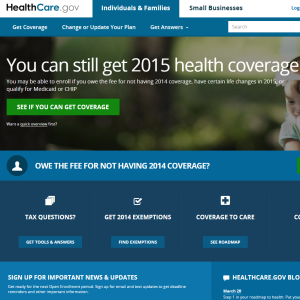During the recent oral argument in King v. Burwell — the Supreme Court case deciding if providing subsidies to buy health insurance in the 36 states utilizing federal health care exchanges is allowed under the Affordable Care Act (ACA) — Justice Kennedy suggested that disallowing subsidies might be unconstitutionally coercive because “states are being told either create your own exchange, or we’ll send your insurance market into a death spiral.” Are “death spirals” real, or just a way to frighten the public?
The death spiral will purportedly happen like this: disallowing federal exchange subsidies will make insurance less affordable for the 87% of federal exchange enrollees currently receiving subsidies. These people will no longer be required to buy insurance since the ACA’s individual mandate only applies to individuals who have access to affordable insurance. Since the ACA imposes community rating, requiring roughly the same premium for all individuals in a given plan with only small adjustments for their risk characteristics, and guaranteed issue of insurance regardless of the enrollee’s health, the old and unhealthy will continue to buy coverage but the young and healthy will forego coverage. The resulting higher risk pool of enrollees will increase the average cost of individuals remaining in the non-group insurance market, both on and off the exchanges, resulting in increased premiums that will drive out more low cost, healthy patients eventually destroying the market.
Two economic simulations predict that “adverse selection,” where healthier people leave the insurance market and sicker people stay in causing premiums to rise, will occur if the King plaintiffs prevail. The Urban Institute predicted discontinuing federal exchange subsidies would result in premium increases of 35% and enrollment declines of 69% in the individual health insurance market. The Rand Corporation made similar predictions.
But it is hard to reconcile these forecasts with studies of earlier state insurance market “reforms” that created market conditions similar to those that would result if federal exchange subsidies are disallowed. These studies suggest adverse selection would be minimal and would not lead to a “death spiral,” that is, it would not lead to a self-reinforcing cycle of adverse selection in which each time premiums rise, more people exit, leading to a sicker, more expensive risk pool and market collapse.
Prior to the ACA most states had little or no restrictions on insurance rates taking account of enrollees’ health risks. In the 1990s a small number of states imposed community rating and guaranteed issue in their health insurance markets, as the ACA has done, but without any subsidies, exactly the same situation that will result on the federal exchanges from a plaintiffs’ victory in King v. Burwell. It was widely predicted these states would experience an adverse selection death spiral. A 1999 National Bureau of Economic Research (NBER) paper by Thomas Buchmueller and John Dinardo compared New York, which had imposed community rating and guaranteed issue, with neighboring states. They “found no evidence for the conventional wisdom that the imposition of pure community rating tends to an adverse selection death spiral.” Similarly, another 2006 NBER paper by Bradley Herring and Mark V. Pauly compared states with community rating and guaranteed issue to states with no such regulations. They found a small increase in the number of uninsured, but did “not observe a strong positive relationship between risk status and the likelihood of being covered, that would be consistent with so-called death spirals.”
If no death spiral occurred in New York which had a “pure community rating” requiring a single premium with no adjustment of any type for individual risk factors, then a spiral is less likely to occur under the ACA which permits risk adjustment by age bands of up 3:1 and tobacco use bands of 1.5:1. Unlike New York, some riskier patients pay a higher premium under the ACA. This should moderate adverse selection.
Moreover, if no death spiral occurred in state markets with enrollees of all income types, there is little reason to believe a death spiral would follow a plaintiff’s victory in King v. Burwell where the enrollees losing subsidies are people who would presumably be otherwise unable to afford insurance. High risk, but poor, enrollees will not suddenly have the wherewithal to buy insurance, and the few who scrape together the money for premiums will quickly reach a price where they cannot afford higher premiums. The market would settle at an equilibrium risk profile and premium level where no additional patients, high or low risk, are willing or able buy insurance. Any “spiral’ would stop.
Predictions of a death spiral are also likely inaccurate because the market is not static; it is already adjusting to the prospect of a plaintiff’s ruling. Unlike the Obama administration which claims it is standing pat, insurers are making contingency plans. The Herring and Pauly NBER study reported that community rating precipitated a shift — in the structure of the small group and individual markets — away from indemnity insurance and toward less costly, managed care plans. The ACA has already produced a similar shift toward lower cost plans with narrow provider networks and no out-of-network benefits. Insurers, whose main interest is retaining enrollees, would likely accelerate this trend to lower premiums and keep insurance affordable without subsidies.
Finally, it should be noted that the insurance market Justice Kennedy worried about, i.e., the individual health insurance market, represents only a small fraction of the overall health insurance market. Most Americans are covered through their employer, through large group insurance or government insurance (Medicare and Medicaid). Any adverse selection in the individual market will not affect most peoples’ insurance.
Disallowing federal subsidies will not, as the conventional wisdom claims, inexorably lead to catastrophe. But having Supreme Court Justices speculate about complex and rapidly changing market dynamics is a worrisome way to make law. The Supreme Court should decide King v. Burwell by interpreting the statute as written and leave it to the legislature to resolve disruptions, if any occur.

